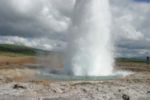Geysers
|
||
Strokkur geyser erupting (clockwise from top left)
|
A geyser (US pronunciation: /ˈɡaɪzər/; UK /ˈɡiːzər/ or /ˈɡaɪzər/) is a spring characterized by intermittent discharge of water ejected turbulently and accompanied by steam.
As a fairly rare phenomenon, the formation of geysers is due to particular hydrogeological conditions that exist in only a few places on Earth. Generally all geyser field sites are located near active volcanic areas, and the geyser effect is due to the proximity of magma. Generally, surface water works its way down to an average depth of around 2,000 metres (6,600 ft) where it contacts hot rocks. The resultant boiling of the pressurized water results in the geyser effect of hot water and steam spraying out of the geyser's surface vent (a hydrothermal explosion).
Over one thousand known geysers exist worldwide. At least 1,283 geysers have erupted in Yellowstone National Park, Wyoming, United States, and an average of 465 geysers are active there in a given year. A geyser's eruptive activity may change or cease due to ongoing mineral deposition within the geyser plumbing, exchange of functions with nearby hot springs, earthquake influences, and human intervention.
...
Wikipedia




